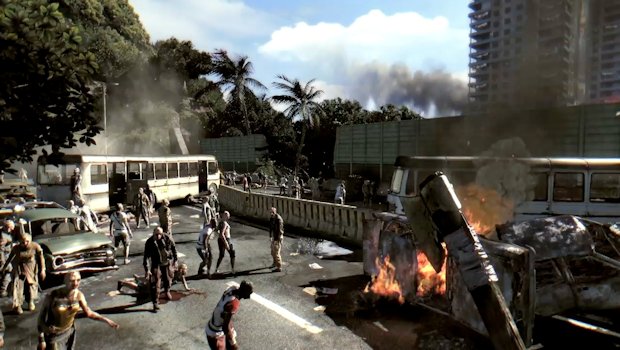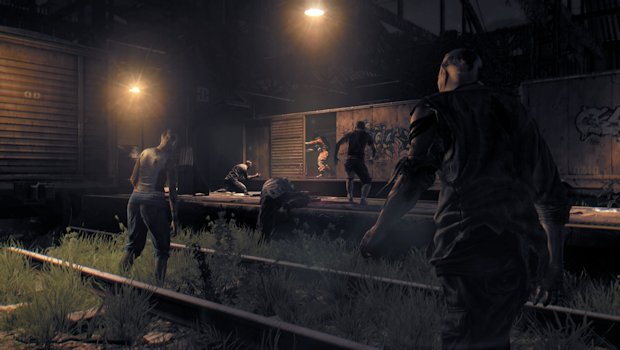When Techland released the trailer for Dead Island, everyone went nuts. It was emotionally captivating and promised something new for the zombie genre. But what we actually played when Dead Island released was nothing like the dramatic trailer. The characters were cookie-cutter stereotypes and the narrative came across as more of the same: not exactly the genre game changer people were hoping for. Still despite the failure to meet the, arguably unfair, expectations, Dead Island was a fun, Fallout-esque open world zombie survival RPG.
You’d be forgiven for thinking that Dying Light, Techland’s latest, is just Dead Island redux for Warner Bros. On the surface everything points to just that. Replace the resort island with a Turkish city and it’s Dead Island with better graphics, right? Well, not exactly. While the similarities between the two games are undeniable, with mechanics and structure being near identical, there are some major differences that elevate Dying Light above its spiritual predecessor.
In Dying Light I was tasked with taking on the role of undercover Global Relief Effort (GRE) operative, Kyle Crane. Crane has sky-dived into the quarantined city of Harran to retrieve a document. I’m not going to lie: the set up is ridiculous. Why would anyone risk sending an operative into a city that they plan on firebombing in short order for a few pieces of paper (let alone such a task being attempted by a humanitarian outfit)? And how undercover is the operative if he skydives into the quarantine zone in broad daylight? Questions of logistics aside, in the first five minutes of the game, Crane lands, gets attacked by a scouting group, gets bitten by an infected resident, and is rescued by another faction group.
Turns out the bite isn’t too dangerous as long as you inject yourself with a medicine called Antizen every once in a while. It’s evidently not a cure, but it does slow the turning process to an insignificant crawl. The bite and the need for medicine come up at certain points in the narrative but it never really plays into the gameplay. Knowing how awful the need for medicine was in Far Cry 2, I can only say thank you that it’s a non-factor in Dying Light. With Crane’s infection stalled, he can go to work on his mission in Harran.
The early game sees Crane working in The Slums, running tasks for the survivor faction that saved him and gathering intel for his main mission. Quickly though Crane realizes that things are more complicated than he was led to believe, and he’ll need to start making some hard choices. The story takes many ridiculous twists and turns but, mostly, the plot is simply a device to get you to explore the city a bit more thoroughly.
With two distinct areas, The Slums and Old Town, Harran is a pretty large city to explore. Much like Dead Island, much of my time in Dying Light is spent scavenging items for survivors with particular needs, or for myself, collecting components to craft new equipment. Yet, crafting in Dying Light is much more hassle-free than it was in Dead Island and can be done by just jumping to the menu, selecting the item you want to craft, and confirming that you want to make it. Crafting, especially of medkits, is an important part of the game and to be able to do so on the fly eliminates one of the biggest issues I personally had with Dead Island.
Crafting can also be used to create new Macgyver-like weapons that combine crazy effects for different results. Personally I never got into the whole “craziest weapon I can make” thing, and stuck with more standard fare that fit my playstyle. But if making a blade that spews poison and lights enemies on fire is your thing, Dying Light will satisfy your urge for Frankenstein weapons.
Part of my aversion to diving headlong into the weapon-making business was due to the fact that Dying Light hangs on to the weapon degradation mechanic of Dead Island. I didn’t like it in Dead Island, or any other game, and I don’t like it here. I understand why it is in place (to encourage players to try multiple different types of weapons) but I don’t want to try multiple different types. When it comes to zombies, I like sharp and quick blades and I don’t want to use anything else.
Fortunately the game mostly gives me the option of not having to engage in combat all too frequently because mobility has been ramped up considerably here. Agility is the name of the game in Dying Light. I could choose to take on a horde of zombies and I might even win, but it’s way more fun to bypass them by running and jumping across rooftops, car hoods, and even the zombies themselves.
Dying Light features a very simplistic but satisfying parkour system for traversing around Harran. Nothing is more satisfying in the game than coming around a corner, seeing a horde of zombies, and then making your own path to avoid them. Nearly everything is climbable and, because of this, the potential for player choice in handling situations is near limitless. It is a welcome change to the formula and its inclusion even makes completing some of the more mundane fetch quest missions a ton of fun.
Of course, you’ll only want to do those mundane missions during the day because once the sun goes down things get really dark and really dangerous. A day/night cycle isn’t anything new in open-world games but Techland makes some great choices to fit the horror theme. When the sun drops on Harran, areas that are not lit by artificial light are barely visible. Techland has made the game very, very dark and this makes traversal at night far more treacherous. And as if that was not enough, when it is dark outside a more dangerous, aggressive, and faster form of infected comes out to play. And they are terrifying.
I’ve played enough horror games over the years that getting scared by anything in them is rare. But being pursued in the dark in Dying Light was actually a frightening experience. The game forces you from time to time to be out after dark, and each of these instances was utterly nerve racking and one I actively attempted to avoid at all costs. And if I accidently got caught outside after dark, away from a safe house, I spent the night cowering in fear crouched behind a counter in a storefront or on a roof out of sight as I waited for the sun to come up. If anything, Dying Light’s nighttime environment is effecting like other games before it have not been.
On a technical level, Dying Light is generally a very good looking game, and it runs quite well too. But when too many zombies get to attacking you, the game does suffer some slight slow down which can cause some unfair deaths. Also, while I thought the game controlled fairly well, there were instances of free running, specifically during the end game, where the controls didn’t seem particularly precise enough. Mostly good though equates to 90% of the title so if you can look past the frustration in the final 10%, it is generally a pretty satisfying game.
In the end, Dying Light doesn’t change things for open-world games, RPGs, or zombie titles. But it does present a wonderfully refined experience that builds on old standards. If any of that sounds intriguing, Dying Light is well worth giving a chance. It’s a content-packed game that provided me with 20+ hours of zombie fun and I can see myself going back to play some more in the downtime throughout the year.
This review was written with material provided by the publisher on the Xbox One console. For more on our review process, please read here.




